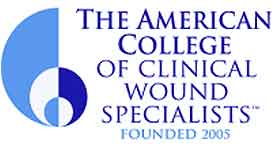In this feature, ACCWS interviews Rose Hamm to learn about her role models and what inspired her to become a PT. Her unquenchable thirst for knowledge, ability to adapt, and willingness to think outside the box in order to solve problems are notable.
Rose Hamm is a physical therapist and a physical therapist wound specialist. She grew up on a farm in North Carolina and graduated from the University of North Carolina where her appetite for knowledge was born. After 14 years she went back to school to get her master’s and post-graduate DPT at the University of Southern California.

What was your inspiration to become a PT and PT wound specialist? Is there a role model you had to inspire you to lead to where you are today?
As a freshman in high school, I read a novel about a ballet dancer who fractured both legs in an automobile accident. The story focused on her rehabilitation and culminated in her awareness that, even though she could no longer dance professionally, she could be a dance teacher. That inspired me to become a PT. Becoming a wound specialist was a gradual process, beginning with first working in an era when all patients with wounds were sent to PT for whirlpool and returned to their rooms for nursing to apply wet to dry dressings. Fourteen years later, a supervisor said to me, “whirlpool and betadine don’t get it anymore” and I attended a course by Carrie Sussman where I first observed Harriett Loehne doing pulsed lavage, removing birdseed from a grapefruit cut in half. I was hooked!!! The greatest inspiration, however, came from my patients who taught me most of what I know about caring for these patients, and from the students who learned to share my passion.

What pearls of wisdom do you have to offer our young upcoming stars in wound care?
First, find a mentor who can help you develop the skills one needs in order to be, not just a good clinician, but an outstanding clinician. This means looking for a facility in which PTs have an active role on the wound care team. If PTs are not involved in wound care at the facility, find a way to contribute and collaborate, to demonstrate what PTs have to offer that other disciplines do not (e.g. exercise and functional activities, total contact casting and orthotic fabrication, sharp debridement, biophysical agents, etc.), and be prepared to show the evidence. Second, network with other PTs in wound care through organizations like the ACEWM and the College. Third, study, study, study!!!! The more informed one is about current evidence-based care, the more likely one is to be included on the wound care team.

Please comment on the regional differences across the USA in regard to PT as wound specialists and managing complex wounds, the scope of practice/limitations, are there regional differences, similarities. What direction is specialization going in wound management/care today?
I do not think the differences are so much regional as they are setting-based. The most important aspect in any setting is having a PT who is passionate about wound care and is willing to put in the initial effort to be a part of the team. Every setting I worked in (including out-patient, in-patient, rehab, long-term care) was receptive to PT being a part of the wound care team, based on the skills offered and collegiality.
Specialization for physical therapists as recognized by the APTA will hopefully help us achieve universal recognition and acceptance as knowledgeable, capable, and caring providers of care to patients with wounds so that all facilities, in all settings, and all regions, will recognize what PTs have to offer these patients.

Briefly tell us about where you grew up, where you went to school and how the bus trip has been up to this point.
I grew up on a farm in eastern North Carolina when the only schools with physical therapy programs were at the University of North Carolina – Chapel Hill (BS program) and Duke University (certificate program). I was ecstatic to be admitted to UNC and had incredible professors who were pioneers in the field such as Margaret Moore, Mary Clyde Singleton, Mabel Parker, Billie Nelson, and George Hamilton. They not only taught us to be good PTs but to be life-long students.
After taking a 14-year hiatus to raise my children, I started back to work part-time, then full-time, and when I realized that while I had the art of being a good PT, my students in the clinic knew more science than I did, and I knew I had to go to graduate school to be a better clinician and educator. I was fortunate to be living in LA so that I could get my master’s and post-graduate DPT at USC, with incredible mentors and professors. One who influenced me the most is Dr. Michael Schneir, a professor in the School of Dentistry, who taught scientific writing and worked with me one-on-one for over a year as I developed my first teaching module for wound care. I give him credit for teaching me everything that has enabled me to publish and edit.

Imagine a world where all disciplines in wound care were on the same page, had parity across all states, and budgets were not an issue. What would your utopian care setting look like?
I had the utopian care setting at USC Keck Hospital. The medical staff were receptive and supportive to the nth degree, the hospital staff were collaborative and grateful, the administrative staff was supportive (although they did not involve me enough initially in the billing process), and the patients were loyal and beyond grateful. We were allowed to bring in new therapies such as negative pressure, pulsed lavage with suction, UVC to treat bioburden, and total contact casting.
The residents and fellows were, with very few exceptions, receptive to learning what we had to share with them about wound care, and there was always someone on call who could help us in emergency situations. The hospital was committed to being state of the art while maintaining a personal, compassionate, and collegial approach to patient care. And I personally loved the intensity of working in that environment. As our responsibilities grew, so did our PT wound care staff, most of whom were students who became colleagues, so that when I retired I felt confident that the program would continue to flourish, as it has under the leadership of Stephanie Woelfel, Angela Kwan, Jeff Thompson, and Terry Richardson.






